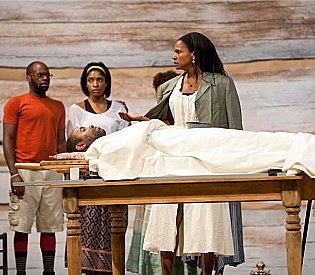I just got back from a month on the road, and in today’s Wall Street Journal drama column I report on two of the shows I saw there, American Players Theatre’s The Critic and the Oregon Shakespeare Festival’s August: Osage County. Here’s an excerpt.
* * *
It isn’t quite right to say that nobody does “The Critic” nowadays, but Richard Brinsley Sheridan’s play, written in 1779, is far less familiar to American audiences than “The School for Scandal” and “The Rivals,” the works of his that remain perennially popular. The current revival by Wisconsin’s American Players Theatre appears to be the first professional production of any consequence to be mounted in this country in the past decade. Yet “The Critic” is one of the best comedies ever written, a backstage farce that offers infinite opportunity to a resourceful director and a cast of virtuoso farceurs. Fortunately, APT has both at its disposal, and William Brown has whipped up a staging whose full-tilt frenzy is strong enough to knock down a building or two.
 Mr. Puff (Jim DeVita), the play’s central character, is an unashamedly venal press agent who introduces himself as “a practititioner in panegyric, or—to speak more plainly—a professor of the art of puffing, at your service, or anybody else’s.” He also fancies himself a playwright, and approaches the well-heeled Mr. Dangle (Darragh Kennan) and the waspish Mr. Sneer (Jonathan Smoots), a pair of opinionated connoisseurs, in the hopes of enlisting their support for his latest effort…
Mr. Puff (Jim DeVita), the play’s central character, is an unashamedly venal press agent who introduces himself as “a practititioner in panegyric, or—to speak more plainly—a professor of the art of puffing, at your service, or anybody else’s.” He also fancies himself a playwright, and approaches the well-heeled Mr. Dangle (Darragh Kennan) and the waspish Mr. Sneer (Jonathan Smoots), a pair of opinionated connoisseurs, in the hopes of enlisting their support for his latest effort…
Mr. Brown has covered Sheridan’s witty cake with a thick and tasty frosting of slapstick so elaborate as to defy any attempt at accurate description. All I can tell you is that I’ve never laughed so hard in my life…
Sometimes a play that makes a strong first impression fails to hold up on repeat acquaintance. Not having seen “August: Osage County” since it opened on Broadway, I was eager to find out whether it was as powerful as I remembered, so I made a point of catching the Oregon Shakespeare Festival’s version. I’m happy to report that it looks as good—maybe even better—the second time around, in part because Christopher Liam Moore’s staging is so satisfying but mostly because the play itself is a wonderfully sound piece of work, a group portrait of collective self-loathing that is all the more devastating for using humor to make its points.
Though the original production was more than funny enough, Mr. Moore and his cast have opted for a more broadly comic portrayal of what one of the members of Mr. Letts’ fictional clan describes as “the creepy character of the Midwest.” If you saw Steppenwolf’s version of the play, you may find this approach to be disconcerting at first, but OSF’s resident ensemble never stoops to caricature, and the results are every bit as effective in their own way….
* * *
Read the whole thing here.
Archives for September 2, 2011
TT: Rewriting Porgy and Bess
Few letters to the editor have stirred up as big a fuss as the one that Stephen Sondheim sent to the New York Times apropos of American Repertory Theater’s new production of Porgy and Bess. In my “Sightings” column for today’s Journal, I talk about that fuss and the reasons for it. Here’s an excerpt.
* * *
 Stephen Sondheim pulled the pin on a jumbo hand grenade when he sent a letter to the New York Times last month in which he took issue with American Repertory Theater’s Broadway-bound production of “Porgy and Bess,” which opened this week in Cambridge, Mass. To be sure, Mr. Sondheim hadn’t actually seen the show, but that didn’t stop him from blasting the “arrogance” of Diane Paulus, the show’s director, and Suzan-Lori Parks, a Pulitzer-winning playwright who has done what by all accounts is a drastic rewrite job on the book.
Stephen Sondheim pulled the pin on a jumbo hand grenade when he sent a letter to the New York Times last month in which he took issue with American Repertory Theater’s Broadway-bound production of “Porgy and Bess,” which opened this week in Cambridge, Mass. To be sure, Mr. Sondheim hadn’t actually seen the show, but that didn’t stop him from blasting the “arrogance” of Diane Paulus, the show’s director, and Suzan-Lori Parks, a Pulitzer-winning playwright who has done what by all accounts is a drastic rewrite job on the book.
What made Mr. Sondheim’s letter possible was the fact that the creators of the new version had already discussed it at length with reporters. As Ms. Paulus explained to Playbill, their purpose in rewriting DuBose Heyward’s libretto was “to strengthen the piece dramatically….filling out what’s never been explored, taking the characters steps further, completing them, fully realizing them.” Given the fact that “Porgy and Bess” has a long and hugely successful production history, it may come as a surprise to its admirers that it requires strengthening. It certainly surprised Mr. Sondheim: “Ms. Paulus says that in the opera you don’t get to know the characters as people. Putting it kindly, that’s willful ignorance. These characters are as vivid as any ever created for the musical theater, as has been proved over and over in productions that may have cut some dialogue and musical passages but didn’t rewrite and distort them.”
The new “Porgy” is a work in progress that will continue to be revised between now and January, when it’s scheduled to open on Broadway. For this reason, the Journal has decided not to review the show until then, just as we chose not to review “Spider-Man: Turn Off the Dark” while it was still in previews. That said, Mr. Sondheim’s letter set me to thinking about how and why the great Broadway musicals of the past have been revised after the fact.
Rightly or wrongly, it’s become customary for a musical to undergo a fair amount of tinkering prior to being revived on Broadway. The score is usually reorchestrated for today’s smaller pit bands, and it’s equally common for the book to be revised. In most cases the goal of these latter revisions is to make the show more accessible to modern audiences…
“Music has a face: leave it alone. If you don’t like it, don’t play it; but don’t change it.” So said Paul Hindemith, one of the 20th century’s foremost classical composers. That’s what I think, too—up to a point….
* * *
Read the whole thing here.
TT: Almanac
“It is amazing how complete is the delusion that beauty is goodness.”
Leo Tolstoy, The Kreutzer Sonata
